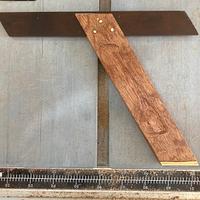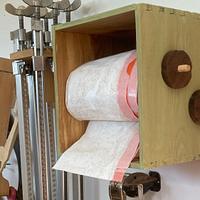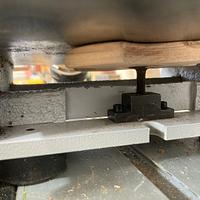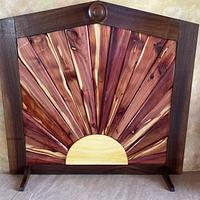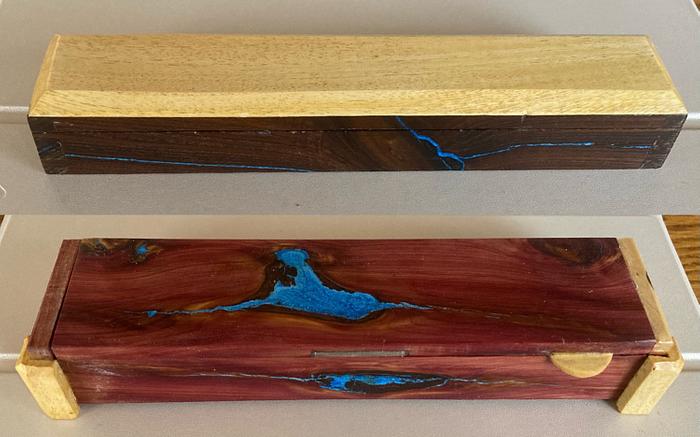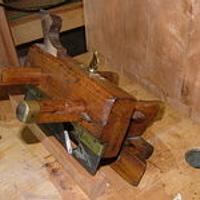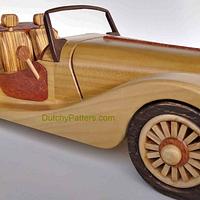Share your craft projects
Make new craft buddies
Ask craft questions
Blog your craft journey

Dave Polaschek
2159 posts
and
43 followers
in over 3 years
in over 3 years
More from Dave Polaschek
Pen boxes
I made a pair of boxes to hold pens recently. They're made with local wood, though I used some citrus from Arizona for accents. Both will be given away by a local non-profit at their anniversary celebration in October.
The first box is Russian olive from La Capilla Hops Farm in La Cienega, New Mexico. We buy greens from Shawn and Kevin nearly every week, and when Kevin learned that I did woodworking, he offered me some Russian olive. It tends to crack a lot as it dries, but I milled one log into small lumber, and then filled the cracks with epoxy with a blue pigment in it.

The box is dovetailed together and has a top of citrus wood from Arizona. The bottom is more Russian olive. There are ash inserts inside the box which serve to align the top and hold it in place. The box is finished with seven to ten coats of Tried and True Varnish Oil, and then a coating of carnauba wax to give it a nice shine.

The pen within the box is a pen made from cholla from our yard in Eldorado at Santa Fe filled with a resin with purple pigment in it. The metal on the pen has a gunmetal finish, which I thought worked nicely with the purple resin.
The second box is made from Rocky Mountain Juniper, harvested near Taos, NM. A fairly large knot and bark inclusion have been filled with resin with a blue pigment, which really stands out against the almost purple reddish-brown juniper. Again, the box is dovetailed, but this time with a juniper lid which is hinged. The corners of the box are covered with citrus feet, and the lift for the lid is also made from citrus.

The bottom of this box is granadillo, which has a nice brown color that worked well with the juniper. The lid is held shut by a magnet in the lid which engages with two small magnets embedded in the front of the box. The box is finished with seven to ten coats of Tried and True Varnish Oil and a coat of carnauba wax.

The pen within the box is also made with juniper, though this time from our yard in Eldorado. The metal hardware is gold and chrome, which work well with the reddish juniper.
May you have the day you deserve!
18 Comments
Great work! Beauty!
Ryan/// ~sigh~ I blew up another bowl. Moke told me "I made the inside bigger than the outside".
What beautiful gifts!
Lovely boxes and pens
Ron
The contrast with the fills is awesome!
Nice looking pens too, really like the colors of the Cholla pen.
What did you put on the R. Olive to get it so dark? I usually use Danish oil which gives me a nice brown that I can,t really get from any other wood. The darker version is something I'd like to play with, I have a goodly amount of that stinky wood! 🤔
Nice looking pens too, really like the colors of the Cholla pen.
What did you put on the R. Olive to get it so dark? I usually use Danish oil which gives me a nice brown that I can,t really get from any other wood. The darker version is something I'd like to play with, I have a goodly amount of that stinky wood! 🤔
Great gifts Dave! They should be a big help for the non-profit.
Great to see such beautiful handcrafted timber goods given to support local community groups, top marks
Life’s Good, Enjoy Each New Day’s Blessings
GR8 JOB on Gifts 😍😎👍
*TONY ** Denver * ALWAYS REMEMBER TO HAVE FUN
Thanks, folks!
Splint, I put Tried and True Varnish Oil on it. Might’ve had a single coat of Real Milk Paint’s Half and Half on first, but I don’t remember for sure. This Russian olive came from bigger trees than I’ve ever seen before. They grew in the creek-bottom of La Cienega near Santa Fe, and I’ve got logs too big to resaw on my old Delta 14 inch bandsaw with a riser. I’ve been splitting them with a froe, and then milling them on the table-saw if I want lumber, and it’s all that color.
If you need a chunk, let me know. I’m sure we can work something out. Or if you’re after a bunch, I can set you up with Kevin and he’ll give you as much as you’d like to haul away. He’s trying to clear all the Russian olives and get cottonwoods growing there instead, and it’s maybe 5 acres of creek-bottom he’s clearing.
For the colors, the blue is System Three’s Klickitat Cast FX pigment and the purple is the Montlake pigment. Their color guide has all the available colors, and I’m slowly trying them out.
Splint, I put Tried and True Varnish Oil on it. Might’ve had a single coat of Real Milk Paint’s Half and Half on first, but I don’t remember for sure. This Russian olive came from bigger trees than I’ve ever seen before. They grew in the creek-bottom of La Cienega near Santa Fe, and I’ve got logs too big to resaw on my old Delta 14 inch bandsaw with a riser. I’ve been splitting them with a froe, and then milling them on the table-saw if I want lumber, and it’s all that color.
If you need a chunk, let me know. I’m sure we can work something out. Or if you’re after a bunch, I can set you up with Kevin and he’ll give you as much as you’d like to haul away. He’s trying to clear all the Russian olives and get cottonwoods growing there instead, and it’s maybe 5 acres of creek-bottom he’s clearing.
For the colors, the blue is System Three’s Klickitat Cast FX pigment and the purple is the Montlake pigment. Their color guide has all the available colors, and I’m slowly trying them out.
May you have the day you deserve!
Nice project, the presentation boxes look great. Experimenting with a new wood species sounds like an enjoyable experience allowing plenty of creative thinking.
Thanks Dave, I've got some T&T somewhere.
I have a lifetime supply of the RO, an invasive species in the bosque so there is always plenty to cut. I've settled for <12" that I can resaw but typically I'll just use the chain saw for the initial split.
Cracking is common, I just use old exterior house paint to seal the ends (planked out at 2" thick) and I get a fairly good yield. I love the look of the quarter sawn, but flat tends to crack less IME.
I tried splitting, but most grow in a slight twist so resawing gets tricky.
I have a lifetime supply of the RO, an invasive species in the bosque so there is always plenty to cut. I've settled for <12" that I can resaw but typically I'll just use the chain saw for the initial split.
Cracking is common, I just use old exterior house paint to seal the ends (planked out at 2" thick) and I get a fairly good yield. I love the look of the quarter sawn, but flat tends to crack less IME.
I tried splitting, but most grow in a slight twist so resawing gets tricky.
Yeah. I split it and then toss it on the tablesaw, which tends to get me quartersawn pieces. And yes, they crack like crazy. Sealing the ends means they just crack after I’ve made them into boards, rather than before.
I’m experimenting with epoxy-filling some cracks on the whole log, then milling. We’ll see how that turns out. I’ll probably learn something.
I’m experimenting with epoxy-filling some cracks on the whole log, then milling. We’ll see how that turns out. I’ll probably learn something.
May you have the day you deserve!
Nice work; the RO is cool looking. Dark like Texas Ebony.
Thanks, Gary and Jan!
May you have the day you deserve!
Dave,
those pen boxes are nice. Blue epoxy looks great.
those pen boxes are nice. Blue epoxy looks great.
daveg, SW Washington & AZ
Thanks, Dave!
May you have the day you deserve!
Quite beautiful. Well done Dave.
Thanks, swirt!
May you have the day you deserve!









